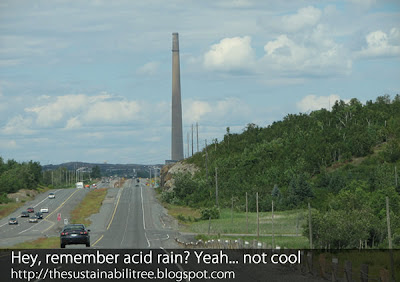As I drive along a road to my grand-father’s house on the week-end, I can’t help but notice the monster smokestacks that spoil Sudbury’s landscape. They can be spotted from miles away; towering over the (unusually) short vegetation and blackened granite. You can actually see a line where the exposed rocks have been blackened, and the recently broken or weathered rocks are pink and light grey (their natural color). Then it happened; a terribly geeky science moment! I remembered reading about acid rain problems in Sudbury being the cause for the lack of lush forest and bountiful wildlife; all because of the mega-smokestacks:
Acid rain is produced when pollutants such as sulfur dioxide (SO2) are chemically transformed to sulphuric acid in the atmosphere; they are then transported and eventually deposited in the form of rain or snow. Over 90% of acid rain in North America is the result of burning fossil fuels for energy (such as coal), and more importantly smelting or refining sulphur-bearing metal ores (Sudbury – NICKEL SMELTING!).
Over 100 years of nickel smelting by companies like Inco and Falconbridge near Sudbury shocked the surrounding landscape and waters. Acidic smelter emissions contaminated the air, and species’ pH tolerance limits were exceeded. The vast forest basically disappeared (hundreds of kilometres) along with the aquatic life of the beautiful lakes. Much of the worst damage was done in the early years of operation, when the ore was smelted over huge, open wood fires.
Since the 1970’s, due to public and media concern (thank you!), new smelting processes and the construction of high smokestacks (including the 391 meter superstack in the picture) have reduced the local and overall impacts of emissions; however, the smokestacks simply sent the polluted air somewhere else. Again, due to public pressure, in 1985, the Ontario government unveiled its Countdown Acid Rain Program, which required Inco to decrease its containment of SO2 by 90%. In 1994, the company met the government’s deadline for reducing SO2 emissions to a maximum annual level of 265 000 tones.
As Sudbury’s air quality improved, and as lake water quality also improved, extensive land and aquatic restoration efforts began. From 1981 through 1998, thousands of students and others helped reclaim 4700 hectares of heavily degraded land. Limed, fertilized, and planted with grasses, legumes and millions of shrubs, conifers, and hardwood trees, Sudbury’s landscape is recovering. Insects, birds, and mammals are coming back. An unexpected ecological benefit – the decline in lake and river acidity – has prompted efforts to restore aquatic systems as well.
If you ever visit Sudbury, stop along the road to look at the blackened land and restoring vegetation. This is a great example of a human-made environmental disaster; we did not take the time to study the impacts of the expanding smelting industry before it was too late, and we reacted rather than prevented.
photo credit - brigitte morin









Comments